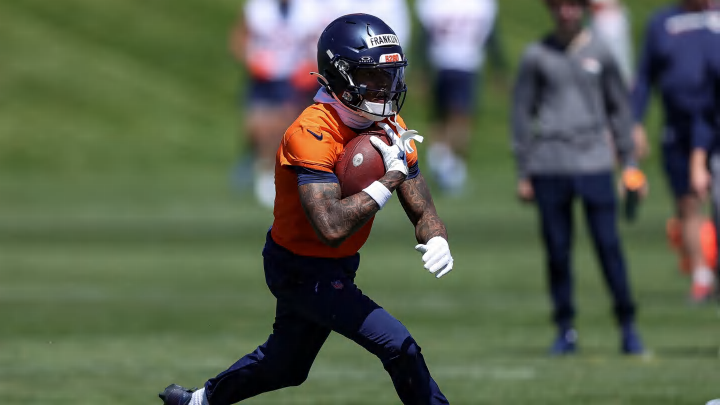Film Room: 4 Ways WR Troy Franklin Upgrades Broncos Offense & One Concern

Explosive offensive plays are a major factor in today’s NFL, and despite adding multiple different options to the roster over the past few seasons, the Denver Broncos have lacked a trustworthy option capable of placing fear in opposing defenses for several years.
Multiple factors have gone into these struggles, including but not limited to poor quarterback play, terrible play calling, and an overall lack of players developing along the way. The Broncos have invested a handful of draft picks and millions of dollars into the skill positions over the past half-decade, but nobody has stood out as the guy.
The Broncos traded a few late-round draft picks to acquire the 102nd overall selection from the Seattle Seahawks in this year's NFL draft, selecting Oregon’s Troy Franklin to reunite him with his collegiate quarterback Bo Nix.
According to several draft scouts throughout the pre-draft process, Franklin was considered a top-100 player and a possible second-round pick due to his ability to create explosive plays in the vertical passing game.
I went to the film room to watch Franklin's tape against Utah, Oregon State, and Washington State in the 2023 college football season. Let's examine my observations of what he brings to the table.
Legitimate Game-Changing Speed
It took less than five minutes to find an example of Franklin’s long strides taking the top off the defense, which he showed early in the first quarter against Utah. Like a shot out of a cannon, Franklin blows by the cornerback on a simple go route.
Sure, there looks to be some defensive miscommunication before the snap, but this speed flashes all over Franklin’s tape.
Straight Line Speed pic.twitter.com/O6C9gF8wkB
— Lance Sanderson (@LanceS_MHH) June 25, 2024
When Franklin can open his strides and use his incredibly long legs to eat up ground, he's nearly impossible to keep up with. He makes it incredibly difficult for cornerbacks to stay in phase and can erase angles in the deep half of the field, making him a true game-changing deep threat. Better ball placement from Nix here could turn this play into a touchdown.
Release Packages Against Press Coverage
One of the more difficult aspects of playing wide receiver in the NFL is learning the nuances of beating press coverage at the line of scrimmage. It takes a combination of footwork, hand placement, functional strength, and a determination to win to be successful.
Franklin already possesses a multitude of different releases off the line of scrimmage, most notably through his footwork.
Nice Release pic.twitter.com/Jq9VDFokQb
— Lance Sanderson (@LanceS_MHH) June 25, 2024
Here against Washington State, Franklin baits the slot cornerback with a subtle jab-step to fake toward the inside, opening up the fade route back toward the outside. Once the cornerback stops his feet and opens his shoulders, he uses his explosive first step to get to full speed and blow by the defender.
While this is a simple example, it also shows the basis of how Franklin baits his defenders into presenting an opening for him to get to his biggest strength. He uses subtle jab steps and shoulder misdirection to put defenders on their heels before accelerating to top speed.
Body Control
When it comes to body control, many people often think of high-flying contested catch receivers who make spectacular catches in tight quarters. Franklin isn’t that kind of player, but he still shows great body control when working the sidelines and tracking the football in the air.
Balance, body lean, and acceleration to deceleration are all examples of body control. Franklin shows all of these aspects on this comeback route against Washington State, including a toe-tap reception to top it all off.
Nice footwork and body Control pic.twitter.com/D3BT5ItUf6
— Lance Sanderson (@LanceS_MHH) June 25, 2024
Watch as Franklin accelerates to top speed to erase the defender’s cushion, slams on the brakes to create separation, and then hammers the gas again to get to the ball along the sideline. He shows balance at the catch point, spatial field awareness to get both feet down, and gets the offense back on track after a negative play put them behind the chains.
Franklin showed this level of body control on another outbreaking route against Oregon State that kept a drive alive early in the contest.
Separation Ability
One of the most underrated aspects of Franklin’s game is his ability to create separation between defenders as a route runner. While there are some inconsistencies in his route running due to his long leg strides and high hips, Franklin found success with his body control and nuance in his craft.
Separation ability pic.twitter.com/Med1nB0hBG
— Lance Sanderson (@LanceS_MHH) June 25, 2024
Through a combination of speed variation, body control and choppy footwork, Franklin showed that he could create gobs of separation, including this three-play stretch on the same drive against Utah. Even though Franklin wasn’t targeted on any of these routes, he was definitely wide open.
There are times when Franklin’s high hips and footwork out of his breaks can cause some serious issues. His long legs struggle to slow down and bite when he tries to eat the defender’s cushion, allowing them to regather their momentum and retrace their steps back to the football, like this play against Oregon State.
high hips are an issue as a route runner pic.twitter.com/OJE7naB3zB
— Lance Sanderson (@LanceS_MHH) June 25, 2024
Frustrating Drops
The first job of a wide receiver is to find a way to get open. The second job is to catch the football. While watching these three particular games, I saw Franklin drop four catchable passes, including the first play in this article.
Frustrating drop pic.twitter.com/CLDeVf12w6
— Lance Sanderson (@LanceS_MHH) June 25, 2024
This was the most egregious and frustrating. This drop came on 3rd-&-9 and forced Oregon to punt the football against Utah early in the game.
If Franklin had made this catch and been tackled at the catch point, Oregon’s offense would have had a chance at going for a fourth-down conversion or attempting a long field goal. He also had inside leverage to slip a tackle and make a play with the ball in his hands.
Follow Mile High Huddle on X and Facebook and subscribe on YouTube for daily Broncos live-stream podcasts!
